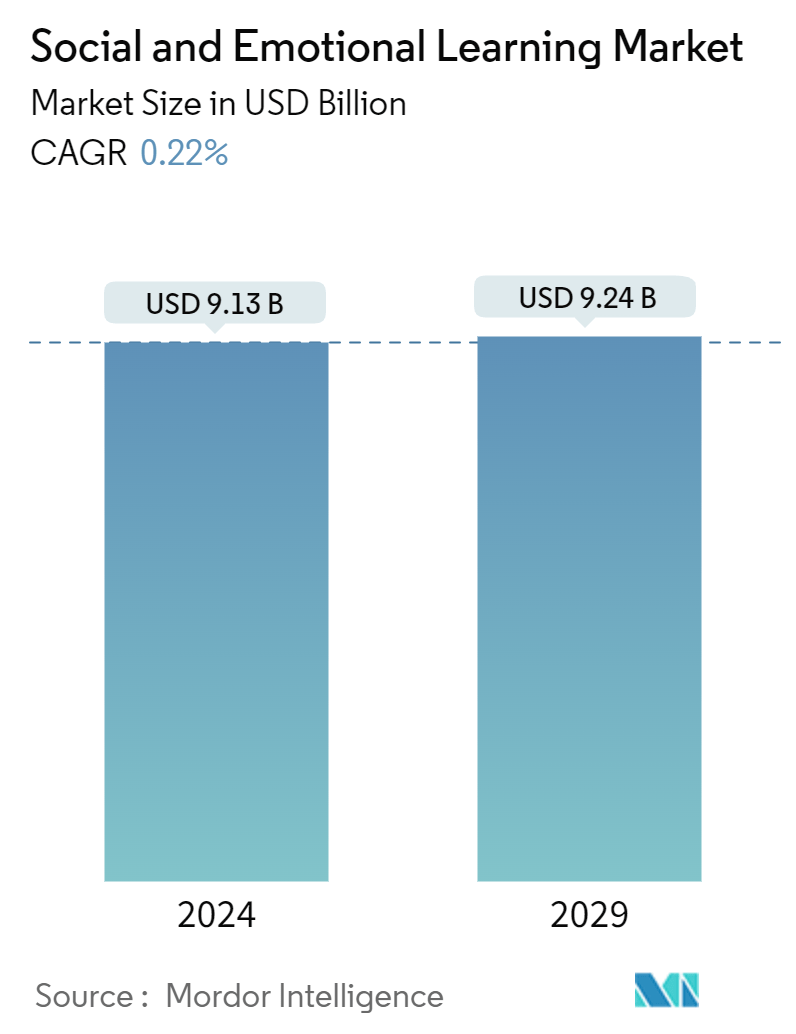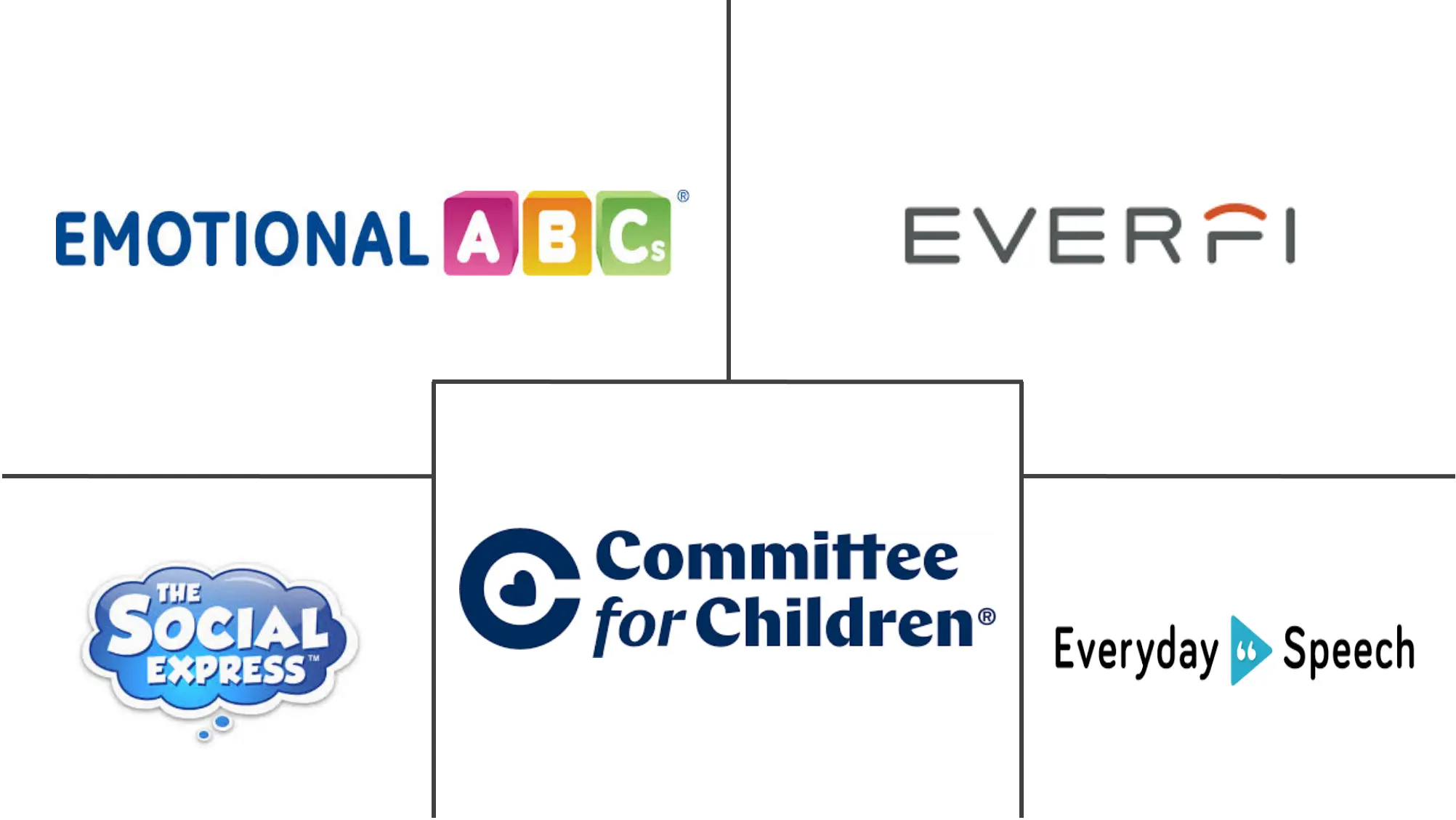Market Size of Social And Emotional Learning Industry

| Study Period | 2019 - 2029 |
| Market Size (2024) | USD 9.13 Billion |
| Market Size (2029) | USD 9.24 Billion |
| CAGR (2024 - 2029) | 0.22 % |
| Fastest Growing Market | Asia Pacific |
| Largest Market | North America |
| Market Concentration | Medium |
Major Players
*Disclaimer: Major Players sorted in no particular order |
Social And Emotional Learning Market Analysis
The Social And Emotional Learning Market size is estimated at USD 9.13 billion in 2024, and is expected to reach USD 9.24 billion by 2029, growing at a CAGR of 0.22% during the forecast period (2024-2029).
- Social-emotional learning (SEL) refers to the development of self-awareness, self-control, and interpersonal skills that are essential for achieving success in school, work, and various aspects of life. Those who possess strong social-emotional skills are better equipped to navigate everyday challenges and experience academic, professional, and social benefits. From effective problem-solving to self-discipline, from impulse control to emotion management, and beyond, SEL lays the groundwork for positive, lasting effects on children, adults, and communities.
- SEL plays a crucial role in laying the groundwork for students to thrive in both their personal and academic lives. By arming children with social-emotional skills, they become more adept at absorbing knowledge and fostering a harmonious school environment. Effective implementation of SEL initiatives has a direct impact on students' achievements within educational settings. Research indicates that mastering social-emotional competencies, such as problem-solving, self-discipline, emotional regulation, and empathy, leads to enhanced academic performance, decreased instances of harmful social conduct such as bullying, and the cultivation of a supportive classroom atmosphere.
- The implementation of SEL (and comparable educational theories) in public schools has been a topic of growing debate since 2020, particularly in the United States. Numerous research studies are ongoing to analyze the effects of social-emotional learning in the school curriculum. Recent research has shown that SEL has numerous advantages, such as reducing emotional stress, enhancing coping mechanisms, and decreasing instances of bullying. Additionally, SEL underscores the significance of equipping students with the necessary skills to become informed, accountable, and compassionate individuals in society as they transition into adulthood.
- The statistical correlation between the implementation of SEL and the improvement of social dynamics in schools is evident through the reduction of physical aggression and bullying toward students with disabilities. The market growth in the education sector is being propelled by the widespread use of smart devices and increasing digitalization. As the educational sector undergoes digitization, social and emotional education is becoming increasingly important in the global modernization and transformation of the learning environment. Additionally, government initiatives aimed at promoting digital infrastructure are playing a crucial role in driving the adoption of SEL.
- Various governments and organizations worldwide play a crucial role in advocating for the adoption of Social and Emotional Learning (SEL) as an integral part of the fundamental curriculum. In the United States, federal policies are pivotal in establishing an environment that facilitates the widespread implementation of SEL at state and district levels, ensuring that all students can reap its advantages. The integration of SEL into educational programs has proven to yield numerous benefits, such as improved academic achievements, decreased disciplinary problems, and enhanced social interactions. SEL also fosters the promotion of mental and emotional well-being among children and adolescents.
- Numerous educators face difficulties when incorporating innovative learning approaches. Additionally, the current educational framework must be adjusted to facilitate social-emotional learning (SEL). Designing a curriculum that caters to the unique requirements of students poses a global challenge for educational institutions. The substantial financial investment needed for SEL initiatives in developing nations is anticipated to be a major obstacle in the market.
- After the COVID-19 pandemic, there has been a transition from online learning to a combination of online and offline learning. This shift has presented various challenges for students and educators across the globe. Educators have had to juggle their personal lives while quickly adapting to the demands of online and offline modes of learning. The pandemic highlighted the importance of social and emotional learning (SEL) and has underscored the necessity for a more holistic approach to children's education and growth.
Social And Emotional Learning Industry Segmentation
- Social and emotional learning (SEL) is a process developed to lead children and adults to understand and manage emotions, set and achieve positive goals, reduce anxiety, boost confidence, establish positive relationships, improve social interactions, etc. SEL helps students and adults succeed in school and life.
- The social and emotional learning market is segmented by component, end user, and geography. By component, the market is divided into solutions and services. By end user, the market is segmented into pre-K, elementary schools, and middle and high schools. By geography, the market is segmented by North America, Europe, Asia-Pacific, and Rest of the World.
- The market size and forecasts are provided in terms of value (USD) for all the above segments.
| By Component | |
| Solutions | |
| Services |
| By End User | |
| Pre-K | |
| Elementary School | |
| Middle and High Schools |
| By Geography | |
| North America | |
| Europe | |
| Asia-Pacific |
Social And Emotional Learning Market Size Summary
The social and emotional learning (SEL) market is experiencing a gradual expansion, driven by the increasing recognition of its importance in education. As educational institutions worldwide adapt to the challenges posed by the COVID-19 pandemic, the focus on SEL has intensified. Governments and educational organizations are actively promoting the integration of SEL into core curricula, recognizing its role in enhancing academic performance and student well-being. The market is characterized by a moderate level of fragmentation, with key players like Emotional ABCs, Everfi, Inc., and Committee for Children leading the charge. These companies are leveraging strategic collaborations and technological advancements to expand their reach and improve their offerings, catering to the growing demand for effective SEL programs.
The market's growth is further supported by federal initiatives and funding, particularly in the United States, where policies are being implemented to prioritize SEL in schools. The American Rescue Plan Act has provided significant financial resources to support the implementation of SEL programs, creating opportunities for educational technology companies to innovate and expand their services. The shift towards digital and remote learning solutions has also facilitated the development of new SEL curricula and tools, such as the Second Step Elementary digital program and Panorama for Positive Behaviors. These developments underscore the critical role of SEL in fostering a supportive learning environment and addressing the mental health challenges faced by students and educators alike.
Social And Emotional Learning Market Size - Table of Contents
-
1. MARKET INSIGHTS
-
1.1 Market Overview
-
1.2 Industry Attractiveness - Porter's Five Forces Analysis
-
1.2.1 Bargaining Power of Suppliers
-
1.2.2 Bargaining Power of Buyers
-
1.2.3 Threat of New Entrants
-
1.2.4 Intensity of Competitive Rivalry
-
1.2.5 Threat of Substitutes
-
-
1.3 Assessment of the Impact of COVID-19 on the SEL Industry
-
-
2. MARKET SEGMENTATION
-
2.1 By Component
-
2.1.1 Solutions
-
2.1.2 Services
-
-
2.2 By End User
-
2.2.1 Pre-K
-
2.2.2 Elementary School
-
2.2.3 Middle and High Schools
-
-
2.3 By Geography
-
2.3.1 North America
-
2.3.2 Europe
-
2.3.3 Asia-Pacific
-
-
Social And Emotional Learning Market Size FAQs
How big is the Social And Emotional Learning Market?
The Social And Emotional Learning Market size is expected to reach USD 9.13 billion in 2024 and grow at a CAGR of 0.22% to reach USD 9.24 billion by 2029.
What is the current Social And Emotional Learning Market size?
In 2024, the Social And Emotional Learning Market size is expected to reach USD 9.13 billion.

